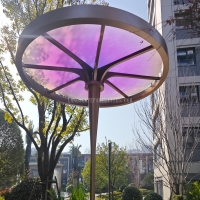Welcome to the website for landscape facilities products and knowledge.
What are the most effective ways to incorporate wind-resistant features into landscape table designs?
Designing landscape tables that withstand strong winds requires a combination of strategic planning, durable materials, and innovative engineering. Here are the most effective ways to ensure your outdoor tables remain stable and functional even in windy conditions:
1. Choose Heavy or Anchored Bases: Opt for tables with weighted bases or those that can be anchored to the ground. Materials like concrete, stone, or thick metal provide natural stability.
2. Low-Profile Designs: Tables with lower heights and minimal surface area reduce wind resistance, preventing tipping. Sleek, aerodynamic shapes are ideal for windy locations.
3. Perforated or Slatted Surfaces: Tables with perforations or gaps allow wind to pass through, reducing pressure buildup and improving stability.
4. Durable, Flexible Materials: Use materials like powder-coated aluminum or marine-grade polymers that resist corrosion while maintaining flexibility to absorb wind stress.
5. Modular or Stackable Features: Modular designs allow tables to be reconfigured or stored easily during extreme weather, while stackable options reduce wind exposure when not in use.
By integrating these features, landscape tables can remain functional and visually appealing, even in challenging outdoor environments.
Related search:

Recommendation
Metal frame with gradient color acrylic combined with high-end shading landscape facilities